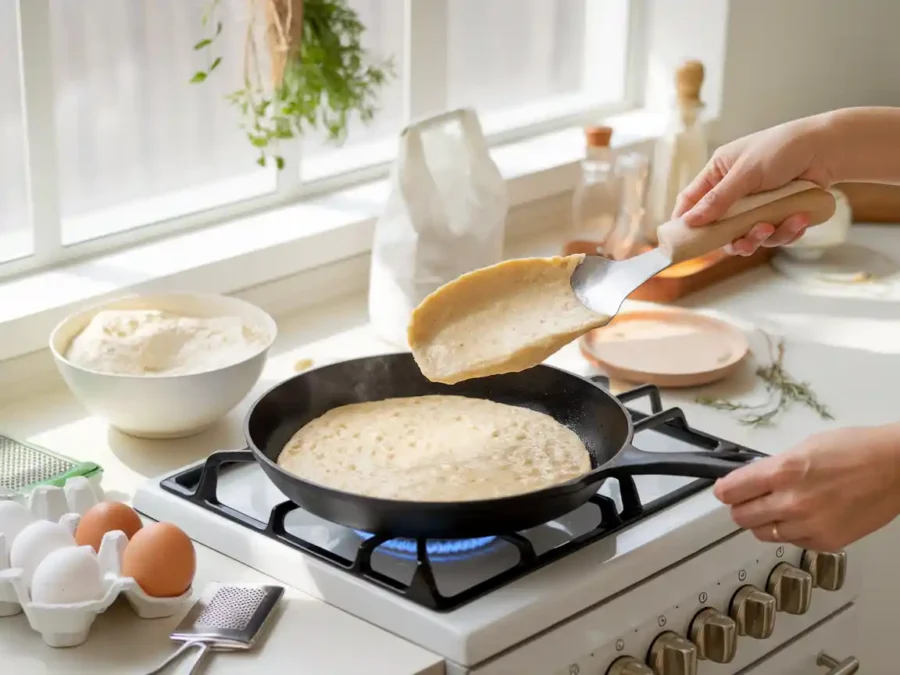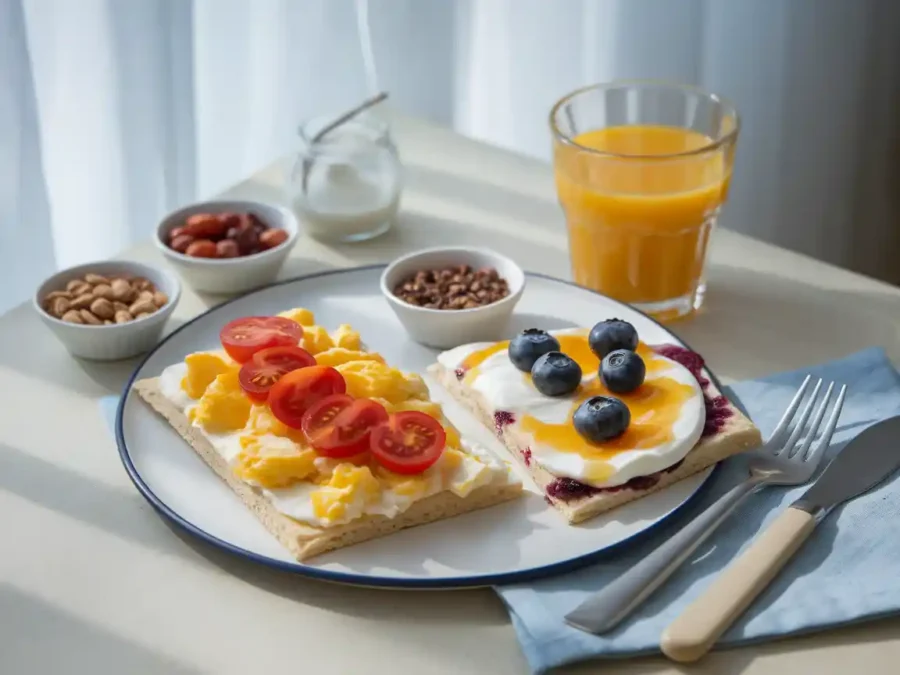When it comes to quick, healthy, and versatile recipes, cottage cheese flatbread has taken the spotlight. This protein-packed dish has been a favorite among fitness enthusiasts, food bloggers, and busy cooks alike. Whether you’re craving a savory bite or a sweet treat, cottage cheese flatbread adapts beautifully to your needs. In this guide, we’ll explore its origins, nutritional benefits, and popular variations, along with foolproof steps to make it at home. Let’s dive right in and uncover what makes this flatbread so irresistible!
Table of Contents
Introduction
Cottage cheese flatbread has become more than just a recipe; it’s a culinary trend that caters to the health-conscious and food lovers alike. But what exactly is it, and why is it so popular? Let’s explore.
What is Cottage Cheese Flatbread?
At its core, cottage cheese flatbread is a simple combination of cottage cheese, flour (or alternatives), and seasonings baked or cooked to perfection. This flatbread stands out because of its soft yet firm texture and its ability to pair well with various toppings. Whether you enjoy it as a snack, a side, or a meal base, this dish offers endless possibilities.
The secret ingredient cottage cheese is what makes this flatbread a nutritional powerhouse. It’s high in protein, low in fat, and has a subtle tang that enhances the flavor of any recipe. Plus, it’s quick to prepare, making it perfect for anyone short on time.
Why is Cottage Cheese Flatbread Trending?
Social media platforms like TikTok and Instagram have played a huge role in catapulting cottage cheese flatbread into the spotlight. With influencers sharing creative spins on this dish, its appeal has grown far beyond the fitness community.
But the appeal isn’t just about aesthetics. People love how this flatbread caters to modern dietary needs, such as low-carb, gluten-free, or high-protein lifestyles. Its adaptability to both sweet and savory flavors ensures there’s something for everyone.
Health Benefits of Cottage Cheese Flatbread
Nutritional Profile of Cottage Cheese Flatbread
One of the standout features of cottage cheese flatbread is its impressive nutritional profile. This dish is naturally high in protein, thanks to its key ingredient cottage cheese. A single serving often provides over 15 grams of protein, making it a go-to option for those looking to build or maintain muscle. Cottage cheese is also low in fat, and when paired with whole-grain or gluten-free flours, the flatbread becomes a fiber-rich powerhouse.
Additionally, cottage cheese contains calcium, which supports bone health, and B vitamins, which boost energy. This combination of nutrients makes cottage cheese flatbread not just delicious, but also a wholesome meal choice.
Protein Power: Why Fitness Enthusiasts Love It
Fitness enthusiasts adore cottage cheese flatbread because it’s both nutritious and filling. Its high protein content aids in muscle recovery, making it a post-workout favorite. Unlike traditional flatbreads, which can be carb-heavy, this version strikes a balance between carbs and protein, offering sustained energy without a sugar crash.
For a quick and healthy meal idea, you can pair this flatbread with a side of fresh vegetables or a lean protein source like chicken or fish. It’s no wonder this dish has become a staple in the diets of those aiming for a healthier lifestyle.
How to Make Cottage Cheese Flatbread at Home

Essential Ingredients for Cottage Cheese Flatbread
Making cottage cheese flatbread at home requires just a handful of simple ingredients. Here’s what you’ll need:
- Cottage cheese (the star of the recipe)
- Flour (whole wheat, almond, or gluten-free options work well)
- Baking powder for fluffiness
- Salt for flavor
You can also customize the recipe by adding herbs like rosemary or garlic powder for a savory twist, or a touch of honey for sweetness.
Step-by-Step Preparation Process
- Mix the Ingredients: In a bowl, combine the cottage cheese, flour, baking powder, and salt. Mix until you get a dough-like consistency.
- Shape the Dough: Divide the dough into equal portions and roll each one out into a flat, round shape.
- Cook or Bake: You can cook the flatbreads on a non-stick pan over medium heat or bake them in an oven at 375°F for 10-12 minutes.
- Serve: Once golden and slightly crispy, remove them from the heat and serve with your favorite toppings.
Tips for Perfect Cottage Cheese Flatbread Every Time
- Use slightly dry cottage cheese to prevent a soggy texture.
- Roll the dough evenly to ensure uniform cooking.
- If baking, line your tray with parchment paper to avoid sticking.
This recipe is as versatile as it is easy to make, allowing you to experiment with flavors and cooking methods. If you’re looking for more creative ways to use cottage cheese, you might enjoy exploring related recipes like flourless banana bread.
Popular Variations of Cottage Cheese Flatbread
Sweet vs. Savory Versions
One of the best features of cottage cheese flatbread is its versatility. Whether you crave sweet or savory, this flatbread can adapt to your taste.
For a savory twist, you can mix in chopped herbs like parsley, dill, or thyme. Adding a sprinkle of garlic powder or grated cheese to the dough brings out a rich, bold flavor. Serve it alongside soups or salads for a wholesome meal.
On the other hand, sweet versions are equally delightful. Add a drizzle of honey, a dash of cinnamon, or even mashed bananas to the dough. Pair this variation with fresh fruit or a dollop of yogurt for a healthy dessert alternative.
Looking for more sweet inspirations? Check out this banana bread recipe for another creative way to enjoy sweetened bread recipes.
Gluten-Free and Low-Carb Adaptations
For those with dietary restrictions, adapting cottage cheese flatbread to meet gluten-free or low-carb needs is simple. Swap traditional flour with almond or coconut flour to reduce carbs and make the dish gluten-free.
Low-carb enthusiasts often pair this version with avocado, smoked salmon, or a poached egg to create a filling breakfast or lunch option. These adaptations make the flatbread even more inclusive and appealing to a wide audience.

Troubleshooting Common Issues
Why Is My Cottage Cheese Flatbread Soggy?
Sogginess can be a common issue, especially if the dough is too wet. Cottage cheese naturally contains moisture, so using a slightly drier variety or draining excess liquid can help. Adding a bit more flour to the dough also balances the texture, ensuring a perfectly cooked flatbread.
Cooking at the right temperature is essential. If the heat is too low, the flatbread may cook unevenly, leaving it soft and soggy in the center. Be sure to cook it on medium heat or bake it at the recommended temperature for the best results.
How to Achieve the Perfect Texture and Thickness
Getting the ideal texture and thickness for your cottage cheese flatbread requires some practice. Roll the dough out evenly too thick, and it might not cook through; too thin, and it can dry out.
Using parchment paper while baking ensures even heat distribution and prevents sticking. If you prefer pan-frying, a non-stick skillet is your best friend. And don’t forget to preheat the pan this simple step can make all the difference in achieving a crispy exterior and soft interior.
The Cultural and Culinary Significance of Flatbreads
Flatbreads Across Different Cultures
Flatbreads have been a staple food across cultures for centuries, each region contributing its unique twist. From Indian naan to Middle Eastern pita, flatbreads are cherished for their simplicity and adaptability.
Cottage cheese flatbread offers a modern take on this ancient tradition, combining the classic flatbread format with the nutritional benefits of cottage cheese. Its versatility reflects the universal appeal of flatbreads, bridging traditional culinary practices with contemporary dietary trends.
How Cottage Cheese Flatbread Fits Into Modern Diets
In today’s health-conscious world, cottage cheese flatbread represents a perfect fusion of taste and nutrition. It aligns with various dietary needs, including high-protein, low-carb, and gluten-free lifestyles. Its quick preparation and adaptability make it ideal for busy individuals seeking wholesome meals without sacrificing flavor.
Moreover, this flatbread offers endless possibilities for experimentation, whether topped with fresh vegetables for a light lunch or paired with nut butter for a quick breakfast. Its place in modern kitchens underscores how traditional concepts can evolve to meet contemporary preferences.
Where to Find Cottage Cheese Flatbread Recipes and Inspiration
Viral TikTok Trends Featuring Cottage Cheese Flatbread
Social media has revolutionized how we discover and share recipes, and cottage cheese flatbread is no exception. TikTok, in particular, has made this dish a viral sensation. With creators showcasing creative toppings, quick preparation tips, and health-focused variations, it’s no surprise this flatbread has captured the internet’s attention.
From tutorials on rolling the perfect dough to ideas for sweet and savory twists, TikTok provides endless inspiration. The bite-sized video format makes it easy to learn new techniques and adapt the recipe to your liking. If you’re eager to try trending food ideas, browsing #CottageCheeseFlatbread on TikTok is a great starting point.
Trusted Recipe Blogs and Cookbooks
For those who prefer detailed instructions and tried-and-true recipes, food blogs and cookbooks are excellent resources. Websites like TastySara feature a range of recipes, including high-protein snacks and gluten-free dishes that align with cottage cheese flatbread. These resources often include step-by-step photos and expert tips, making the cooking process foolproof.
FAQs
Why Is My Cottage Cheese Flatbread Soggy?
A soggy cottage cheese flatbread is often the result of too much moisture in the dough. Cottage cheese naturally has a high water content, so using a thicker or drier variety can help. If your cottage cheese seems watery, try draining it through a fine mesh strainer or cheesecloth before mixing it into the dough.
Another culprit might be improper cooking temperature. Low heat can leave the flatbread undercooked in the middle, while high heat ensures a crisp outer layer and a soft, cooked interior. Adjusting the amount of flour can also improve the consistency of the dough, making it easier to handle and less likely to result in sogginess.
How Long Does Cottage Cheese Flatbread Last?
Homemade cottage cheese flatbread is best enjoyed fresh, but it can be stored for later use. Once cooled, wrap it tightly in plastic wrap or store it in an airtight container. It can last up to three days in the refrigerator. For longer storage, freeze the flatbread by placing it in a freezer-safe bag or container this method keeps it fresh for up to three months.
To reheat, simply place it in a warm oven or on a skillet to restore its texture and flavor. Avoid microwaving, as this can make the flatbread soggy or chewy.
Does Cottage Cheese Melt Like Cheese?
Unlike aged cheeses like cheddar or mozzarella, cottage cheese doesn’t melt in the traditional sense. Instead, it softens and blends into dishes, adding a creamy texture and mild tang. This quality makes it ideal for cottage cheese flatbread, as it integrates seamlessly into the dough without overpowering other flavors.
If you’re looking for a meltier option, you can combine cottage cheese with a small amount of grated mozzarella to add a stretchy texture while maintaining the health benefits of the flatbread.
Why Is Cottage Cheese Not Keto?
Cottage cheese can be keto-friendly, but it depends on the variety and portion size. While it is relatively low in carbs, some brands contain added sugars or fillers that increase the carb count. For those on a strict keto diet, choosing full-fat, plain cottage cheese with minimal ingredients is essential.
When using cottage cheese for flatbread, pairing it with low-carb flours like almond or coconut flour ensures the final dish stays keto-compliant. With a few mindful adjustments, you can enjoy cottage cheese flatbread without straying from your diet.
Conclusion
A Journey Through Tradition and Innovation
Cottage cheese flatbread beautifully combines timeless culinary techniques with modern dietary needs. Its protein-rich profile and adaptability to various flavors make it a standout choice for meals and snacks. Whether you’re enjoying it as a post-workout meal, a quick breakfast, or a comforting dinner side, this flatbread proves that healthy eating doesn’t have to be boring.
The journey of cottage cheese flatbread from a simple recipe to a global trend highlights the power of creativity in the kitchen. By experimenting with ingredients and techniques, you can tailor this dish to suit your lifestyle and preferences.
A Dish for Every Table
As flatbreads continue to hold a special place in cuisines worldwide, cottage cheese flatbread carves out its own niche. Its ease of preparation, nutritional benefits, and endless customization options make it a dish for every table. Whether you’re a seasoned chef or a kitchen novice, this flatbread invites you to explore, create, and savor every bite.

